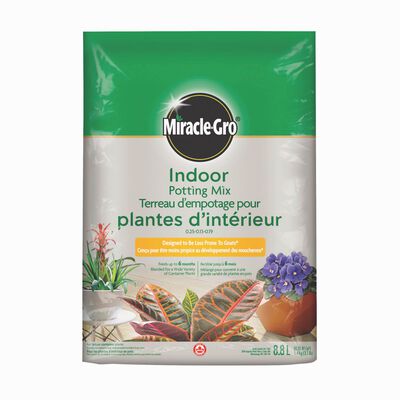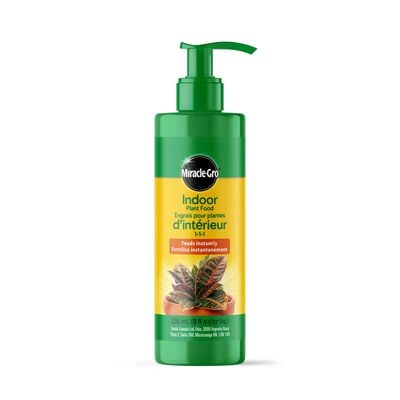
How to Grow and Care for Peace Lilies
- Place plants in bright, indirect light.
- Plant peace lilies in Miracle-Gro® Indoor Potting Mix 8.8L for great results.
- Keep the soil consistently moist but not soggy.
- A month after planting, feed plants with Miracle-Gro® Indoor Plant Food.
- Repot when the plant's roots have completely outgrown its container.
- Be on the lookout for problems and address them as they come up.
Calm, tropical, beautiful. Sounds good, right? You can take a big step toward bringing that sort of ambiance to your favorite room by growing peace lilies. The name "peace lily" came about because the white flowers look like white flags of peace—though they aren't actually lilies. Instead, they're tropical perennials, meaning when you practice good peace lily care, these plants can live for years and flower over and over again. Ideal for home or office growing, they're easy to take care of, don't require a lot of light, and do a wonderful job cleaning and purifying the air. Standing 1 to 4 feet tall, peace lilies are also quite striking, with dark green leaves creating a gorgeous contrast to the white flowers.
Ready to learn how to grow peace lilies?
Where to Grow Peace Lilies
Peace lilies will practically grow in the closet, but that doesn't mean that's where you should put them. When grown in low light, these plants will rarely bloom. So if it's foliage you're after, go ahead and put your peace lily in a dark corner. If you want flowers, though, place it where it will receive bright, indirect light. Just make sure there aren't any drafts—since they're tropical, peace lilies are sensitive to cold temperatures.
One word of caution: Peace lily leaves contain a compound that can cause swelling of the tongue or even vomiting when eaten, so keep your plant away from kids and pets.
How to Plant Peace Lilies
Peace lilies are perfectly happy growing in containers, but they don't like sitting in pots much larger than their root balls. Here's how to plant one:
1. Select a container that has good drainage and is no more than ⅓ larger than the root ball of your peace lily.
2. Fill the container ⅓ of the way with Miracle-Gro® Indoor Potting Mix 8.8L, which contains no compost or bark, both of which are known to shelter pesky fungus gnats. The mix also contains coconut coir, which helps soil re-wet easily.
3. Place the plant in the container so that the top of the root ball is about an inch below the top of the rim (to leave room for watering).
4. Fill in around the root ball with more potting mix.
5. Water your peace lily until moisture begins to drain out the bottom of the pot, then put a saucer under it and move it to its new home.
How to Water Peace Lilies
Peace lilies need consistently moist soil, but they definitely don't like to sit in standing water. Whenever the top inch of soil is dry, water the plant until the overflow starts to come out of the bottom of the container. Wait until it stops draining, then set the pot back in its saucer.
Peace lilies don't usually behave like drama queens, unless you forget to water them. One day your beloved plant is looking gorgeous, then the very next day you find it flopping over in its pot like an exhausted teenager on a sofa. Not to worry! Simply water immediately, let the plant soak it up, and water again. That's it—you're back on track.
How to Feed Peace Lilies
About a month after planting, your peace lily is going to start to get hungry. Give it the nutritious meal it's craving with Miracle-Gro® Indoor Plant Food, which is designed to feed indoor plants instantly. You can apply the plant food directly to the soil or mix it in when you water. Be sure to follow label directions!
How to Repot Peace Lilies
Peace lilies are actually quite happy to be a bit crowded in their pots. You'll know it's time to repot when your plant begins to wilt more frequently. At that point, its roots will have begun to take up so much of the container that there's little soil left to hold water. Select a new container that is just a couple inches wider in diameter than the container in which your peace lily is currently growing, and follow the planting instructions above to repot.
Troubleshooting Problems with Peace Lilies
Peace lily care tends to be pretty straightforward, but you might notice a few issues with these plants (in addition to the wilting mentioned above). Keep any eye out for:
- Fungus gnats. As mentioned above, if you grow peace lilies in Miracle-Gro® Indoor Potting Mix 8.8L, this is less likely to be an issue. But if you're growing in a different type of potting soil, you may need to fight this battle. First, try watering less frequently and make sure the top of the soil dries out between waterings. If that doesn't work, you may need to use Bt (Bacillus thuringiensis, an insecticide for home garden use) to kill the larvae in the soil.
- Yellow leaves. Older leaves on peace lilies will turn yellow with age. Remove them, cutting all the way at the center of the plant. Plants that have been overwatered will sometimes develop yellow leaves, too. Let the soil dry out a bit and cut back on watering, and the plant may recover.
- Brown edges. This is usually a sign that your peace lily has been getting direct sunlight. If that's the case, move the plant out of sunbeams. You can also try elevating the humidity around your plant. Fill the saucer that goes under the pot with small pebbles. Add water, up to about 1/3 inch below the top of the stones. The water will evaporate up around the leaves, raising the humidity.
- Zero blooms. If your peace lily isn't blooming, move it to an area where it will get more bright (but not direct) light.
- Dusty leaves. Peace lily leaves are large and tend to collect dust. You can put the whole plant in the shower and hose it down.
(Want to learn more about the benefits of houseplants? We've got the info.)

